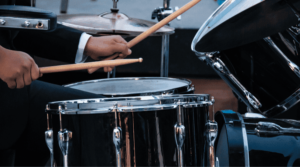Decoding drum notes is a fundamental skill for any drummer aiming for musical mastery. Whether you’re a beginner or an experienced player, understanding drum notation is essential for learning, memorizing, and even creating music. Drum notes act as a universal language that maps out rhythms, dynamics, and articulations, allowing drummers to communicate and share musical ideas accurately. This article explores the basics of drum notation, the significance of drum notes in mastering songs, tools and resources for learning, exercises to enhance sight-reading abilities, and techniques for transcribing drum parts by ear.
Aspiring to greatness on the drums? Let Drum Coach show you how, with only 5 minutes of fun, daily practice. Watch your drumming transform swiftly!
Drum notes and the process to master them
1. Understanding the Basics of Drum Notation
Drum notation differs from traditional musical notation as it is designed to represent rhythm patterns and drum voices rather than musical pitches. Each line and space on the staff corresponds to a specific part of the drum kit, such as the snare drum, bass drum, cymbals, and toms. Notes and symbols indicate when and how to play these components, with various note heads and flags denoting different note values and playing techniques.
The key to decoding drum notes lies in understanding these symbols and their corresponding actions on the drum set. Standard notations include quarter notes, eighth notes, sixteenth notes, and rests, each representing different rhythmic values. Additionally, special markings indicate techniques such as flams, rolls, and cymbal chokes, adding nuance and expression to drum parts.

The key to decoding drum notes lies in understanding these symbols and their corresponding actions on the drum set.
Standard notations include quarter notes, eighth notes, sixteenth notes, and rests, each representing different rhythmic values.
2. The Role of Drum Notes in Learning and Memorizing Songs
Reading drum notes is crucial for learning new songs accurately and efficiently. It allows drummers to understand the song’s structure, rhythm patterns, and dynamic changes without relying solely on auditory memory. This visual representation of music enhances a drummer’s ability to memorize songs by providing a clear framework for the piece, highlighting key transitions, fills, and breaks.
Moreover, drum notation serves as a valuable tool for practicing and perfecting songs. By studying the written parts, drummers can focus on challenging sections, refine their timing, and experiment with different interpretations of the music, leading to a more versatile and expressive performance.
3. Tools and Resources to Help You Master Drum Notes
Several tools and resources are available to help drummers master drum notation. Online tutorials, instructional books, and drumming apps offer lessons on reading and interpreting drum scores. Websites and forums dedicated to drumming often feature downloadable sheet music, exercises, and community support for learners at all levels.
Additionally, drum notation software allows drummers to create, edit, and share their drum parts. These programs often include playback features, enabling users to hear how the notated rhythms sound, which can accelerate the learning process and aid in memorization.
For those looking to take their skills in reading and writing drum sheet music to the next level, the Drumap app is an invaluable resource. Designed specifically for drummers, Drumap offers an intuitive platform where users can learn to read and write drum notation with ease. Whether you’re a beginner seeking to grasp the basics or an experienced player aiming to refine your skills, Drumap provides a comprehensive suite of tools to enhance your learning experience. With access to a wide array of lessons, exercises, and an interactive drum sheet music editor, you’re equipped to tackle the challenges of drum notation head-on. Start your journey toward mastering drum notes by exploring what Drumap has to offer at.
Embracing technology like Drumap can significantly enhance your ability to decode, learn, and create drum music

Embracing technology like Drumap can significantly enhance your ability to decode, learn, and create drum music. By integrating these digital tools into your practice routine, you’ll find yourself advancing more quickly and with greater confidence. The app’s user-friendly interface and robust learning materials make it an essential companion for any drummer dedicated to achieving musical mastery.
Elevate Your Drumming Skills with Drumap Ready to transform how you write, share, and explore drum notes? Download Drumap, the Grammy Academy awarded music app, and join a vibrant community of drummers and percussionists. With Drumap, you have access to:
🎶 Over 150,000 drum samples and percussive rhythms.
📝 Tools to create and share your drum beats effortlessly.
💡 Inspiration and tips from master drummers across all genres.
4. Exercises to Improve Your Sight-Reading Skills
Improving sight-reading skills is essential for quickly learning new songs and adapting to various musical settings. Regular practice with sight-reading exercises can significantly enhance your ability to decode drum notes on the fly. Here are some recommended exercises to bolster your sight-reading abilities:
- Rhythmic Reading: Start with basic rhythmic patterns and gradually increase complexity. Focus on different note values, from whole notes to sixteenth notes, and practice them in various combinations.
- Quarter note rhythms
- Eighth note combinations
- Sixteenth note patterns
- Dynamic Changes: Incorporate exercises that involve sudden dynamic changes. This will help you become more responsive to dynamic markings in sheet music.
- Soft (piano) to loud (forte) passages
- Crescendo and decrescendo within a single bar
- Mixed Meter Reading: Practice reading rhythms in mixed or odd time signatures. This will challenge your ability to maintain a steady pulse and adapt to changing rhythmic structures.
- Switching between 4/4 and 3/4 time
- Reading and playing in 5/8 and 7/8 time signatures
- Sight-Reading New Pieces Daily: Dedicate a portion of your practice time to sight-reading entirely new pieces. Start with simpler pieces and gradually increase the difficulty as your confidence grows.
- Simple song structures
- Complex pieces with varying rhythms and dynamics
- Practice with a Metronome: Using a metronome while sight-reading can help you maintain a consistent tempo. Challenge yourself by gradually increasing the tempo as you become more comfortable with the piece.
- Play-Along Tracks: Use play-along tracks or apps that provide backing tracks. This offers a more engaging practice session and helps improve your timing and rhythmic feel.
- Call and Response Exercises: Play a rhythm and then write it down (or use a software/app that simulates this exercise). This can improve your ability to translate what you hear into notation, enhancing both your reading and listening skills.

Regular practice with sight-reading exercises can significantly enhance your ability to decode drum notes on the fly
By incorporating these exercises into your daily practice routine, you’ll not only enhance your sight-reading skills but also develop a deeper understanding of rhythm, timing, and dynamics. These skills are crucial for mastering drum notation and achieving fluency in musical expression. Remember, consistency is key. Regular practice, even in short sessions, can lead to significant improvements over time.
5. How to Transcribe Drum Parts by Ear and Notate Them
Transcribing drum parts by ear is a powerful skill that combines auditory perception with your understanding of drum notation. This process involves listening to a piece of music, identifying the drum parts, and notating them accurately. Transcribing not only improves your ear for music but also deepens your understanding of rhythm and drumming techniques.
To start transcribing, listen to the song several times to get a feel for the overall structure and rhythm. Focus on one drum component at a time, such as the bass drum or snare, and write down the rhythms you hear. Gradually add in the other parts, checking your transcription against the recording to ensure accuracy.
Transcribing drum parts by ear as drum notes is a powerful skill that combines auditory perception with your understanding of drum notation

Closing comments on drum notes
Mastering drum notation and sight-reading opens up a world of musical possibilities. By understanding the basics of drum notation, leveraging tools and resources, practicing sight-reading, and learning to transcribe by ear, drummers can unlock their full potential and achieve musical mastery. As you continue to explore and practice, remember that each piece of music is an opportunity to refine your skills and express your unique musical voice. Keep an eye out for accompanying images and sheet music examples that will further illustrate these concepts and enrich your learning experience.
Ready to elevate your drumming skills? Start your journey to greatness with Drum Coach! Dive into our Drumming Essentials course designed for beginners. With Drumming Essentials course you get:
🥁 5 minutes of fun, daily exercises.
🎵 A beginner-friendly approach to improve steadily.
💡 Engaging lessons that make learning easy and effective.
Get ready to take your drumming to the next level. Get expert tips on coordination, drumming techniques, improvisation and more in the post titled “Charting Your Drumming Journey”. / Written by: Raul Rodrigues: CEO of Drumap, Drummer, Music School Director and Mariano Steimberg: Drum Professor at Berklee College of Music, Valencia Campus.










